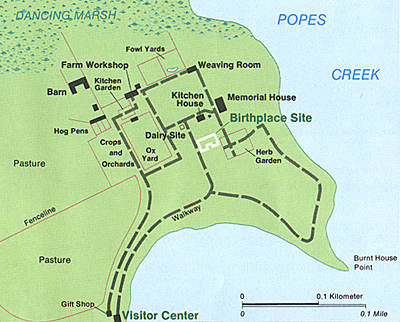 Many of you may think George Washington's birthplace was Mount Vernon. Not true, as I was to learn. It was in a place called Popes Creek (no apostrophe between the "e" and "s") in the Tidewater section of Virginia. It's about a dozen miles west of where Robert E. Lee was born, though time precluded us from visiting that homestead.
Many of you may think George Washington's birthplace was Mount Vernon. Not true, as I was to learn. It was in a place called Popes Creek (no apostrophe between the "e" and "s") in the Tidewater section of Virginia. It's about a dozen miles west of where Robert E. Lee was born, though time precluded us from visiting that homestead.
Popes Creek Plantation is a US National Monument and an authentic place where George Washington slept. It's situated about 35 miles east of Fredericksburg, roughly along Route 3, but better along Route 218, which also leads up to the entrance. The entrance fee is $3 per person, payable at the Visitor's Center.
The state of Virginia bought the homesite and burial ground in 1858 to mark and protect them, but the Civil War put a halt to the process. The state donated the land to the Federal Government in 1882. The Wakefield National Memorial Association formed in 1923 to recover and restore the grounds, which became a National Monument in 1930. In 1931, aided by John D. Rockefeller, Wakefield bought land to increase the size of the grounds to 394 acres and the monument opened to the public under the National Park Service the next year.
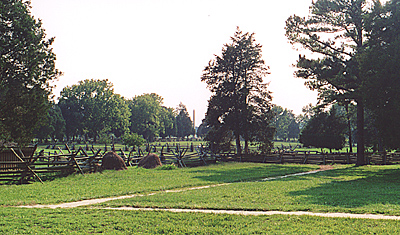 At the entrance to the Monument stands a memorial granite shaft (center of photo) erected in 1896 on the site of where the archeologists of the time thought the actual house was located. It was moved to the entrance in the middle of a traffic circle in 1930, where Vermont marble was used to create a 1:10 scale version of the Washington Monument in Washington DC.
At the entrance to the Monument stands a memorial granite shaft (center of photo) erected in 1896 on the site of where the archeologists of the time thought the actual house was located. It was moved to the entrance in the middle of a traffic circle in 1930, where Vermont marble was used to create a 1:10 scale version of the Washington Monument in Washington DC.
Turning right at the shaft towards the Visitor's Center, it's a short one-minute drive to the parking lot. A few display cases house artifacts found during excavations, and several information boards offer an overview of the Washington Family.
Meet the Washington's
Lawrence Washington was a clergyman in Essex, England, who lost his position in 1643. His son, John, went to sea and in 1657 landed in Virginia, eventually marrying the daughter of a local planter, Nathanial Pope, who gave the couple 700 acres to raise tobacco. John steadily added land to his farm using the "head count" method, by which every man he brought to America rewarded him with more property--he eventually totalled 10,000 acres, including a tract on Little Hunting Creek which would eventually become Mount Vernon.
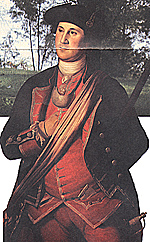 John's son, another Lawrence, was born in 1659, schooled in England, and became a tobacco planter as well as militia captain, sheriff, and member of the colony burgess.
John's son, another Lawrence, was born in 1659, schooled in England, and became a tobacco planter as well as militia captain, sheriff, and member of the colony burgess.
At right: George Washington in his Virginia militia uniform.
Lawrence's son, Augustine, was born in 1694. Upon the death of Lawrence, Augustine moved to England, but later returned to his inheritance and expanded the farm again. Like his father, he was a militia captain and sheriff, as well as holding other positions of local importance.
Augustine's first wife died and he later remarried, to one Marry Bell. Their first child was born February 22, 1732 at Popes Creek: George. He had two step-brothers from Augustine's first marriage, as well as three brothers and two sisters.
Augustine died in 1743, and George, being the third son, received a modest estate at the age of 11, but steadily added more land, married a wealthy widow, and received inheritance from his step-brothers when they died.
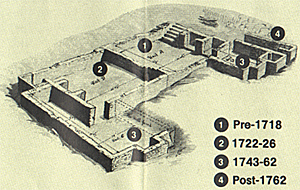 George Washington's Birthplace
George Washington's Birthplace
George only lived at Popes Creek for three and a half years before his father moved the family 80 miles upriver to Little Hunting Creek, where George lived until he was 6 years old. Augustine then moved the family to Ferry Farm across rom Fredericksburg to be closer to his iron businesses. George inherited Ferry Farm when his father died in 1743.
George lived at Ferry Farm until he was 16, although he also spent much time at his step-brother Lawrence's farm at Little Hunting Creek (renamed by Lawrence to be Mount Vernon) and step-brother Augustine jr's farm at Popes Creek. When step-brother Lawrence died in 1752, George rented Mount Vernon from the widow. When she died in 1761, George inherited the property and called Mount Vernon his home.
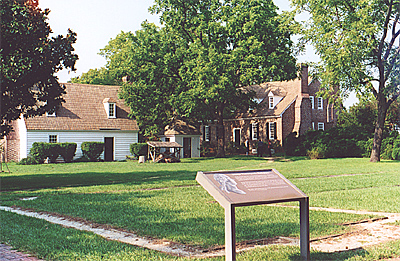 No House, Oyster Shells
No House, Oyster Shells
The original house was started sometime before 1718, with an addition between 1722-1726. Another addition followed in the years between 1743-1762, with a final addition between 1762-mid 1770s. This U-shaped house, though not a grand manor, was still a substantial home boasting 10 bedsteads, 13 tables, 57 chairs, 8 chests, tools for 8 fireplaces, and other household items.
At right: Memorial house to the right, with kitchen to the left. In the foreground, note the oyster-shell outline marking the original house.
When step brother Augustine jr died in 1762, the house at Popes Creek passed to his son William Augustine. On Christmas Day 1779, the house caught fire and burned to the ground, never to be rebuilt.
When archeologists excavated the grounds in 1930, they discovered foundations of a house approximately 80 feet from the location of a kitchen chimney--the last part of the original birthplace that was still standing in 1873, though it collapsed shortly thereafter.
Photo of Kitchen Fireplace (slow: 166K)
Separating the kitchen from the main house was a common practice in the 18th century to, ironically, avoid fires in the main house. The existing kitchen house is a recreation, are are all the buildings on the property.
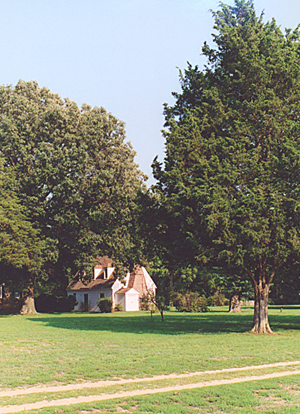
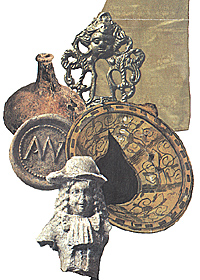 With this in mind, and in order to meet the 200-year anniversary deadline, a Memorial House was constructed in 1930-31 atop those foundations. It was meant as a typical house of the 18th century upper class, with a central hallway and four rooms each on the ground and upper floors. Its bricks were handmade from clay from a nearby field and the house is furnished in typical 1730-1750 style with period antigues.
With this in mind, and in order to meet the 200-year anniversary deadline, a Memorial House was constructed in 1930-31 atop those foundations. It was meant as a typical house of the 18th century upper class, with a central hallway and four rooms each on the ground and upper floors. Its bricks were handmade from clay from a nearby field and the house is furnished in typical 1730-1750 style with period antigues.
At right: the kitchen's west side.
At left: artifacts from excavations.
Photo of Two Rooms Within Memorial House (slow: 143K)
However, further excavations in 1936 found a much larger foundation with abundant artifacts, indicating that the real U-shaped house was in a different spot. The Memorial House was built over foundations of an out-building. Kudos for docent Bob Bowlin for pointing out bits and pieces of the house.
Today, the U-shaped foundations are marked with an outline of crushed oyster shells.
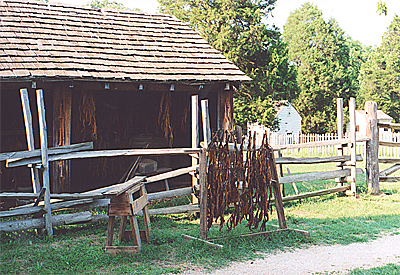 Other Buildings
Other Buildings
The entire Popes Creek Plantation still functions as a working farm, using 18th century methods to harvest crops, grow tobacco, and raise livestock.
Tobacco dries at the farm.
Photo of Spinning Set Up (slow: 104K)
Photo of Interior of Tool/Woodworking Shed (slow: 99K)
As a plantation was more or less self-sufficient, you'll find several reconstructed outbuildings, including the kitchen, stables, and tool room. A herb garden exists near the U-shaped outline.
A short walking trail lets you stroll around the creek and farm buildings. Picnic areas and a nature trail also allow you to view additional sections of the place.
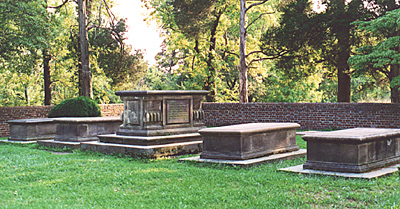 Burial Ground
Burial Ground
The Burial Ground is a short five-minute drive away. A 1930s-era brick enclosure holds a number of replica gravestones and modern memorial tablets designating the gravesites of 32 relatives. George is not one of them.
If you continue past this place, you'll come to a small parking lot offering "beach" access to the Potomac River. It was here that ships were loaded with tobacco and unloaded of imported goods.
Summary
Although I had not heard of Popes Creek and George Washington before, I enjoyed the visit. The way in, especially on the picturesque Route 218 which cuts through rolling wooded terrain, is well marked. If you're in the vicinity of Robert E. Lee's birthplace, George's birthplace is worth a stop and easily seen in an hour or so.
After George's Birthplace, we headed east on Rte 3, then south on Rte 360, crossing the Rappahannock River at Tappahannock, then meandering south along Rte 17. We broke off to cross the York River at West Point, eventually spending the night further south and east at Williamsburg.
Back to List of Historic Sites
Back to Travel Master List
Back to MagWeb Master List of Magazines
© Copyright 2003 by Coalition Web, Inc.
This article appears in MagWeb (Magazine Web) on the Internet World Wide Web.
Other articles covering military history and related topics are available at http://www.magweb.com